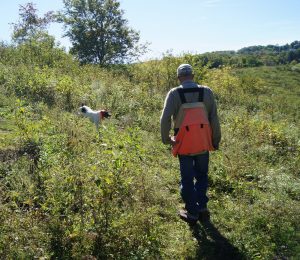Back to Basics: E-Collar
POINTING DOG POINTERS
By Bob and Jody Iler

The e-collar should not take away a dog’s style and class.
We have never wanted to be known as e-collar trainers and have always felt that many a good pointing dog has never needed the added reinforcement of the electronic collar. In fact, an old dog trainer once told us that “the less you use your e-collar, the better.”
If you follow a sensible training plan using basic equipment of six-foot lead, checkcord and whistle, with short but consistent, positive sessions along with proper introduction to birds and the gun, most well-bred pointing dogs may almost seem to train themselves.
So why are we writing a column about the e-collar?
Like we said last month, sometimes that “star pupil” seems like a completely different young dog once he starts hunting and “feeling his oats.” All that hard work seems to have gone up in smoke. Hence—last month’s column on going back to the basics with control and handling work. So before you even think of using the e-collar, read or re-read that column and spend some serious time working on reinforcing what you’ve taught your pup, the old-fashioned way.
Then, if that fails, it’s time to consider using the e-collar. And though we don’t want to be known as e-collar trainers, we do know how to use the collar properly when it’s warranted for control issues as well as for special training purposes such as the trained retrieve and steadying to wing and shot. We’d like to repeat here that we shy away from using the e-collar until the dog has been hunted a season and developed a love of birds and hunting.
Years ago, bulky electronic collars had but one setting or “stimulation”—high! In today’s electronic age, it has been finely tweaked to many levels of stimulation with specific instructions and other fancy add-ons, such as locators and vibration stimulation. The e-collar today is a fine tool for adding the extra “reminder” to a dog that is just not responding to traditional control methods.
The crucial thing to remember is that the foundation of training must have already been laid; the dog must know what the commands mean and what you expect from him when you give these commands. Then, the e-collar can be a wonderful aid as an “invisible” checkcord and reinforcement of what’s been taught. Without this foundation, however, the e-collar can cause a train wreck and ruin a budding pointing dog. The results lie in the hands of the person using the e-collar and his or her knowledge of its proper use.
Because using the e-collar is really an art, the power that it puts in the hands of the average person is fearsome. Make sure you read and understand all directions that come with it; study up on the proper use of the collar through articles or books written by light-handed, gentle pointing dog trainers. What works for a feisty, boisterous lab will not work for a soft or sensitive pointing dog. Contact a trainer if you need help before you begin, not after you’ve created a problem by using it.
Why all this caution?
In our 40 years of training bird dogs, we have seen what improper or overuse of the collar can do. It’s often taken many months of patient back to the basics to undo that damage and sometimes it can’t be undone.
Come at it from the mind of the dog: if you are given a stimulation that you’ve never felt before without understanding why, you might just freeze up. Maybe you try one thing or another to please your handler and it just results in another stimulation and perhaps another. It won’t take long before you decide that hunting and birds and the whole bit just aren’t fun anymore.

Let your dog become used to wearing the e-collar.
The first basic step is to introduce the e-collar. Let your dog wear it for an hour or two for several days and get used to it (while turned off). And before you ever turn it on and put it on your dog, test the various stimulation levels on your own hand or arm. You want only the feel of a “nick” when you hit the button: just enough that your dog will be aware of something different. He’ll let you know this by cocking his head slightly, twitching an ear, or dropping his tail a bit. Make sure you can lock the level in at the desired stimulation, too; some collar controls have a dial that can get accidentally turned up without your realizing it.
Now that you’ve acclimated your dog to the collar, found the proper stimulation to use, and removed birds from the equation for now, you’re ready to begin. The e-collar will later become your “invisible” checkcord, but while your dog is learning, make sure you have a long checkcord on him for training.
Begin your field work as usual. Quarter your dog from side to side, working forward through the field. As you change direction, give your whistle command and pop the checkcord as you’ve been doing to remind him to pay attention. After doing this a few times, change direction again, whistle and pop the checkcord, and at the same time, also give the e-collar stimulation. This requires a bit of coordination on your part!
You should notice a sudden, slight new awareness coming from your dog as you “bump” him lightly with the collar during this training. Because you are adding this new reinforcement to his other reminders (the whistle and the checkcord pop), it shouldn’t take your dog long to absorb that the nick of the e-collar also means “pay attention” to what I’m asking of you and do it.
These sessions should be short and positive. If your dog is responding well, try dropping one of the other training aids as you progress. For example, as you quarter and change direction, eliminate the whistle command and just pop the checkcord while giving the e-collar stimulation at the same time. If the dog responds well, try dropping the checkcord pop and just use the whistle as you “bump” your dog. If he works well with the use of the e-collar stimulation and either the checkcord pop or whistle, you’ll know he has made the connection.
If you follow this process but notice that your dog still isn’t responding as you want him to, it may be reasonable to up the stimulation a notch or so. Remember, you want only enough stimulation that your dog will notice and respond to—absolutely nothing more. Adding a little extra stimulation will usually do the trick. This whole process may take several weeks or more, because you want to read your dog as you go along, making sure he understands this new signal that you are adding to the mix. Repetition and praise are key.
The other control problem of the young dog, not paying attention to your command to come, can also be tweaked by use of the e-collar. To effectively teach him this, you’ll want the dog to not be in the quartering and responsive mode, but rather, just be first out in the field where he is exploring and excited and paying very little attention to you. At that moment, you’ll give your “here” (come) verbal command and pop the checkcord, while simultaneously adding the “bump” from the e-collar.
You may or may not also use a whistle command for here; we like to keep ourselves as quiet as possible in the field so we don’t use a lot of different whistle commands and don’t use one for the here command. Don’t overdo the here command in a session. A few successful recalls are enough. If you overdo, your dog will wise up quickly and simply stay by your side.
The goal of the e-collar training in control is to heighten our dog’s awareness of what we want and “help” him to respond to our control commands in the field and when we call him to us. The fine line between this and developing an enthusiastic pointing dog that loves to hunt is what makes it such an art. Overdo and overuse and your dog will quit hunting. Add just enough reinforcement and your dog will learn to work with you as a team.
As mentioned, there are other training scenarios where proper use of the collar is invaluable. Right now, stick to control work; if you plan on advanced training, the rest can come when your dog is seasoned.
The young dog is like a kid; he’s going to make mistakes. He also needs less control now rather than too much or he won’t stretch his horizons to fulfill his potential. If you err on the side of anything in early e-collar training, let it be less rather than more!
Pointing Dog Pointers features monthly training tips by Bob and Jody Iler, who own Green Valley Kennels in Dubuque, Iowa. Bob and Jody have trained pointing dogs for over 35 years and have written many articles for The Pointing Dog Journal.






